Arab Open University B207A: IKEA's Competitive Strategy Report
VerifiedAdded on 2023/06/10
|9
|2163
|410
Report
AI Summary
This report provides a comprehensive analysis of IKEA's competitive strategy, delving into its core elements of cost leadership, product differentiation, branding, and market focus. It examines how IKEA's marketing strategy, encompassing target markets, marketing mix (pricing, place, promotion, and product), and market positioning, supports its overall competitive approach. Furthermore, the report explores IKEA's operational strategies, including packaging and design, supply chain management, and inventory management, highlighting their crucial role in delivering the company's value proposition. The analysis emphasizes the interconnectedness of these strategies, demonstrating how they collectively contribute to IKEA's market dominance and ability to offer stylish, affordable furniture globally. The report also explores how the company has expanded into new markets.
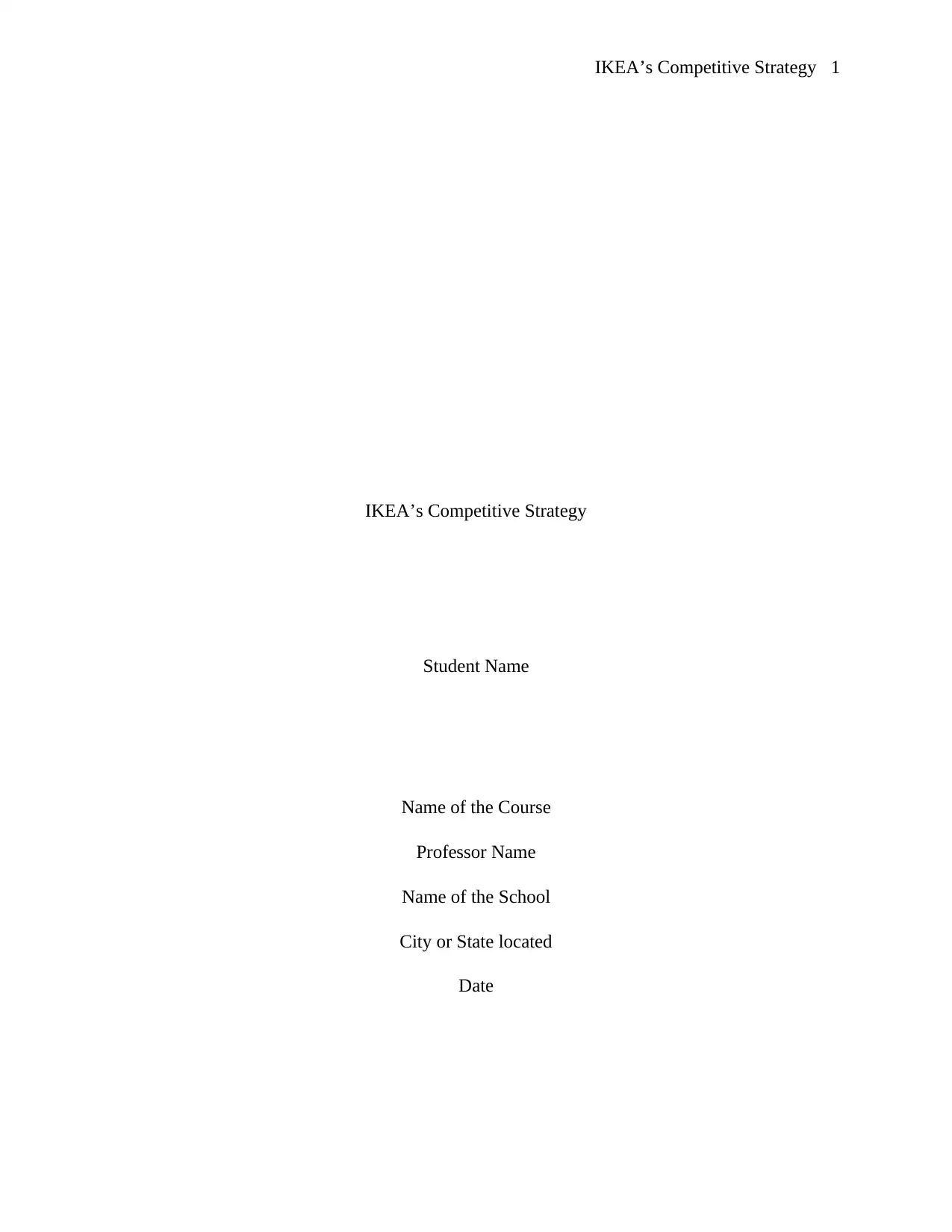
IKEA’s Competitive Strategy 1
IKEA’s Competitive Strategy
Student Name
Name of the Course
Professor Name
Name of the School
City or State located
Date
IKEA’s Competitive Strategy
Student Name
Name of the Course
Professor Name
Name of the School
City or State located
Date
Paraphrase This Document
Need a fresh take? Get an instant paraphrase of this document with our AI Paraphraser
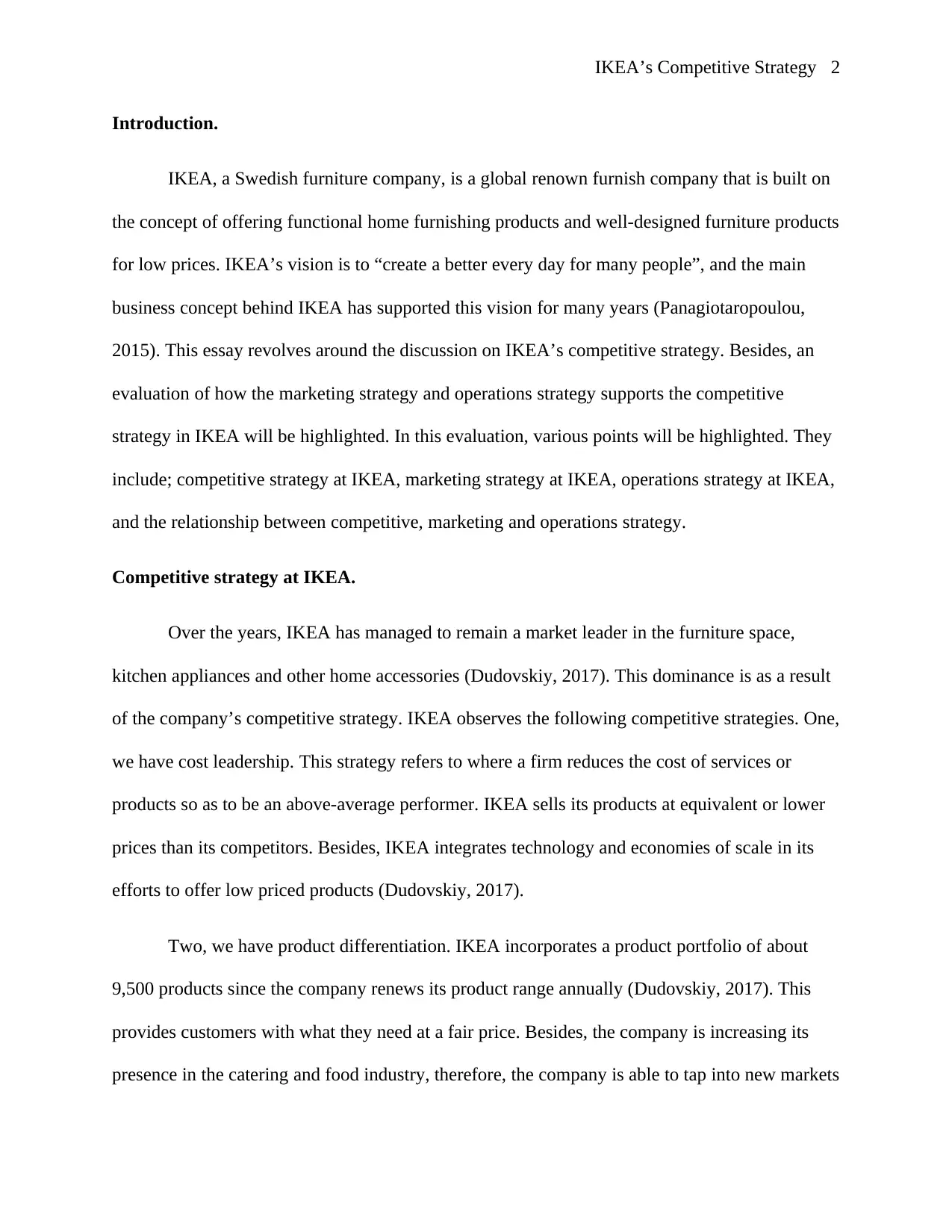
IKEA’s Competitive Strategy 2
Introduction.
IKEA, a Swedish furniture company, is a global renown furnish company that is built on
the concept of offering functional home furnishing products and well-designed furniture products
for low prices. IKEA’s vision is to “create a better every day for many people”, and the main
business concept behind IKEA has supported this vision for many years (Panagiotaropoulou,
2015). This essay revolves around the discussion on IKEA’s competitive strategy. Besides, an
evaluation of how the marketing strategy and operations strategy supports the competitive
strategy in IKEA will be highlighted. In this evaluation, various points will be highlighted. They
include; competitive strategy at IKEA, marketing strategy at IKEA, operations strategy at IKEA,
and the relationship between competitive, marketing and operations strategy.
Competitive strategy at IKEA.
Over the years, IKEA has managed to remain a market leader in the furniture space,
kitchen appliances and other home accessories (Dudovskiy, 2017). This dominance is as a result
of the company’s competitive strategy. IKEA observes the following competitive strategies. One,
we have cost leadership. This strategy refers to where a firm reduces the cost of services or
products so as to be an above-average performer. IKEA sells its products at equivalent or lower
prices than its competitors. Besides, IKEA integrates technology and economies of scale in its
efforts to offer low priced products (Dudovskiy, 2017).
Two, we have product differentiation. IKEA incorporates a product portfolio of about
9,500 products since the company renews its product range annually (Dudovskiy, 2017). This
provides customers with what they need at a fair price. Besides, the company is increasing its
presence in the catering and food industry, therefore, the company is able to tap into new markets
Introduction.
IKEA, a Swedish furniture company, is a global renown furnish company that is built on
the concept of offering functional home furnishing products and well-designed furniture products
for low prices. IKEA’s vision is to “create a better every day for many people”, and the main
business concept behind IKEA has supported this vision for many years (Panagiotaropoulou,
2015). This essay revolves around the discussion on IKEA’s competitive strategy. Besides, an
evaluation of how the marketing strategy and operations strategy supports the competitive
strategy in IKEA will be highlighted. In this evaluation, various points will be highlighted. They
include; competitive strategy at IKEA, marketing strategy at IKEA, operations strategy at IKEA,
and the relationship between competitive, marketing and operations strategy.
Competitive strategy at IKEA.
Over the years, IKEA has managed to remain a market leader in the furniture space,
kitchen appliances and other home accessories (Dudovskiy, 2017). This dominance is as a result
of the company’s competitive strategy. IKEA observes the following competitive strategies. One,
we have cost leadership. This strategy refers to where a firm reduces the cost of services or
products so as to be an above-average performer. IKEA sells its products at equivalent or lower
prices than its competitors. Besides, IKEA integrates technology and economies of scale in its
efforts to offer low priced products (Dudovskiy, 2017).
Two, we have product differentiation. IKEA incorporates a product portfolio of about
9,500 products since the company renews its product range annually (Dudovskiy, 2017). This
provides customers with what they need at a fair price. Besides, the company is increasing its
presence in the catering and food industry, therefore, the company is able to tap into new markets
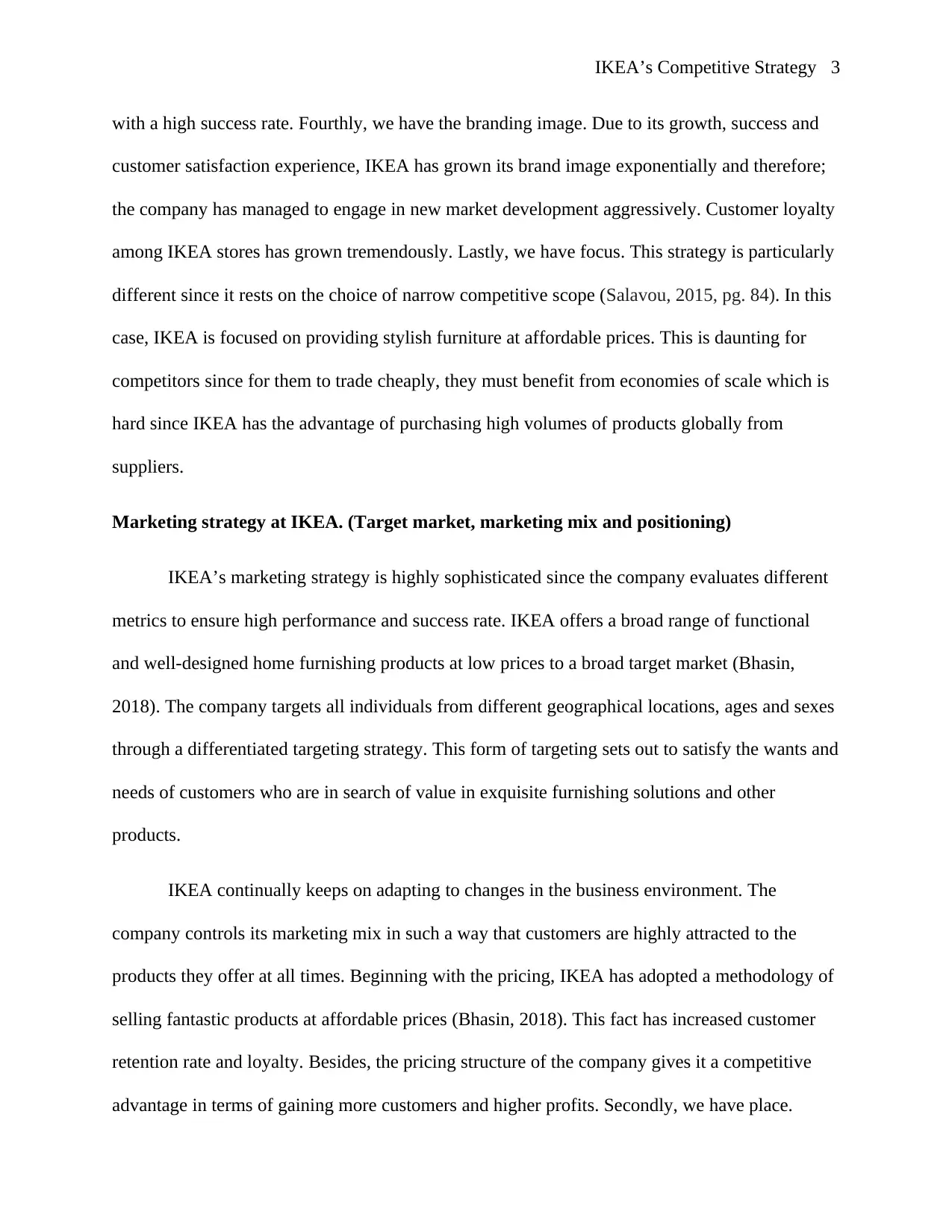
IKEA’s Competitive Strategy 3
with a high success rate. Fourthly, we have the branding image. Due to its growth, success and
customer satisfaction experience, IKEA has grown its brand image exponentially and therefore;
the company has managed to engage in new market development aggressively. Customer loyalty
among IKEA stores has grown tremendously. Lastly, we have focus. This strategy is particularly
different since it rests on the choice of narrow competitive scope (Salavou, 2015, pg. 84). In this
case, IKEA is focused on providing stylish furniture at affordable prices. This is daunting for
competitors since for them to trade cheaply, they must benefit from economies of scale which is
hard since IKEA has the advantage of purchasing high volumes of products globally from
suppliers.
Marketing strategy at IKEA. (Target market, marketing mix and positioning)
IKEA’s marketing strategy is highly sophisticated since the company evaluates different
metrics to ensure high performance and success rate. IKEA offers a broad range of functional
and well-designed home furnishing products at low prices to a broad target market (Bhasin,
2018). The company targets all individuals from different geographical locations, ages and sexes
through a differentiated targeting strategy. This form of targeting sets out to satisfy the wants and
needs of customers who are in search of value in exquisite furnishing solutions and other
products.
IKEA continually keeps on adapting to changes in the business environment. The
company controls its marketing mix in such a way that customers are highly attracted to the
products they offer at all times. Beginning with the pricing, IKEA has adopted a methodology of
selling fantastic products at affordable prices (Bhasin, 2018). This fact has increased customer
retention rate and loyalty. Besides, the pricing structure of the company gives it a competitive
advantage in terms of gaining more customers and higher profits. Secondly, we have place.
with a high success rate. Fourthly, we have the branding image. Due to its growth, success and
customer satisfaction experience, IKEA has grown its brand image exponentially and therefore;
the company has managed to engage in new market development aggressively. Customer loyalty
among IKEA stores has grown tremendously. Lastly, we have focus. This strategy is particularly
different since it rests on the choice of narrow competitive scope (Salavou, 2015, pg. 84). In this
case, IKEA is focused on providing stylish furniture at affordable prices. This is daunting for
competitors since for them to trade cheaply, they must benefit from economies of scale which is
hard since IKEA has the advantage of purchasing high volumes of products globally from
suppliers.
Marketing strategy at IKEA. (Target market, marketing mix and positioning)
IKEA’s marketing strategy is highly sophisticated since the company evaluates different
metrics to ensure high performance and success rate. IKEA offers a broad range of functional
and well-designed home furnishing products at low prices to a broad target market (Bhasin,
2018). The company targets all individuals from different geographical locations, ages and sexes
through a differentiated targeting strategy. This form of targeting sets out to satisfy the wants and
needs of customers who are in search of value in exquisite furnishing solutions and other
products.
IKEA continually keeps on adapting to changes in the business environment. The
company controls its marketing mix in such a way that customers are highly attracted to the
products they offer at all times. Beginning with the pricing, IKEA has adopted a methodology of
selling fantastic products at affordable prices (Bhasin, 2018). This fact has increased customer
retention rate and loyalty. Besides, the pricing structure of the company gives it a competitive
advantage in terms of gaining more customers and higher profits. Secondly, we have place.
⊘ This is a preview!⊘
Do you want full access?
Subscribe today to unlock all pages.

Trusted by 1+ million students worldwide
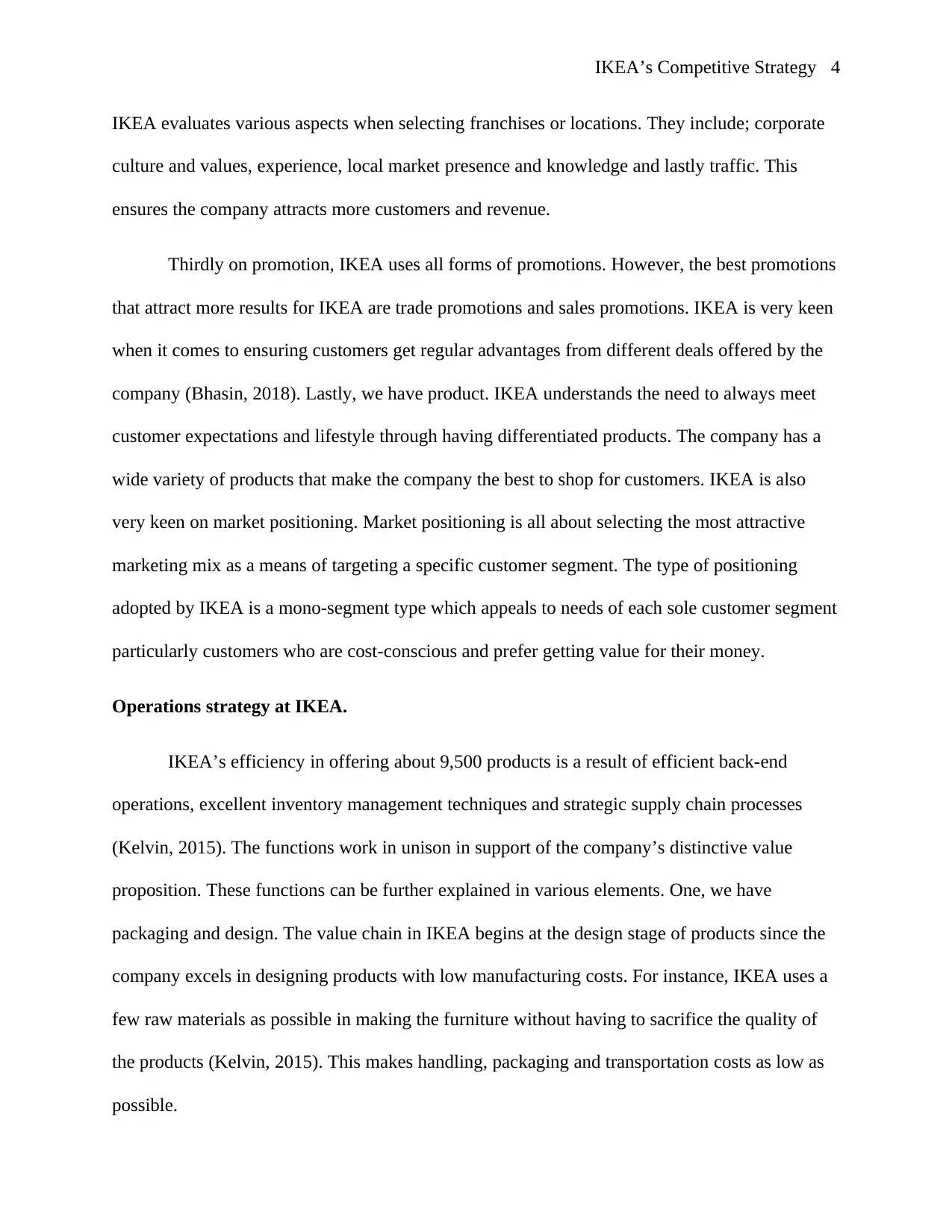
IKEA’s Competitive Strategy 4
IKEA evaluates various aspects when selecting franchises or locations. They include; corporate
culture and values, experience, local market presence and knowledge and lastly traffic. This
ensures the company attracts more customers and revenue.
Thirdly on promotion, IKEA uses all forms of promotions. However, the best promotions
that attract more results for IKEA are trade promotions and sales promotions. IKEA is very keen
when it comes to ensuring customers get regular advantages from different deals offered by the
company (Bhasin, 2018). Lastly, we have product. IKEA understands the need to always meet
customer expectations and lifestyle through having differentiated products. The company has a
wide variety of products that make the company the best to shop for customers. IKEA is also
very keen on market positioning. Market positioning is all about selecting the most attractive
marketing mix as a means of targeting a specific customer segment. The type of positioning
adopted by IKEA is a mono-segment type which appeals to needs of each sole customer segment
particularly customers who are cost-conscious and prefer getting value for their money.
Operations strategy at IKEA.
IKEA’s efficiency in offering about 9,500 products is a result of efficient back-end
operations, excellent inventory management techniques and strategic supply chain processes
(Kelvin, 2015). The functions work in unison in support of the company’s distinctive value
proposition. These functions can be further explained in various elements. One, we have
packaging and design. The value chain in IKEA begins at the design stage of products since the
company excels in designing products with low manufacturing costs. For instance, IKEA uses a
few raw materials as possible in making the furniture without having to sacrifice the quality of
the products (Kelvin, 2015). This makes handling, packaging and transportation costs as low as
possible.
IKEA evaluates various aspects when selecting franchises or locations. They include; corporate
culture and values, experience, local market presence and knowledge and lastly traffic. This
ensures the company attracts more customers and revenue.
Thirdly on promotion, IKEA uses all forms of promotions. However, the best promotions
that attract more results for IKEA are trade promotions and sales promotions. IKEA is very keen
when it comes to ensuring customers get regular advantages from different deals offered by the
company (Bhasin, 2018). Lastly, we have product. IKEA understands the need to always meet
customer expectations and lifestyle through having differentiated products. The company has a
wide variety of products that make the company the best to shop for customers. IKEA is also
very keen on market positioning. Market positioning is all about selecting the most attractive
marketing mix as a means of targeting a specific customer segment. The type of positioning
adopted by IKEA is a mono-segment type which appeals to needs of each sole customer segment
particularly customers who are cost-conscious and prefer getting value for their money.
Operations strategy at IKEA.
IKEA’s efficiency in offering about 9,500 products is a result of efficient back-end
operations, excellent inventory management techniques and strategic supply chain processes
(Kelvin, 2015). The functions work in unison in support of the company’s distinctive value
proposition. These functions can be further explained in various elements. One, we have
packaging and design. The value chain in IKEA begins at the design stage of products since the
company excels in designing products with low manufacturing costs. For instance, IKEA uses a
few raw materials as possible in making the furniture without having to sacrifice the quality of
the products (Kelvin, 2015). This makes handling, packaging and transportation costs as low as
possible.
Paraphrase This Document
Need a fresh take? Get an instant paraphrase of this document with our AI Paraphraser
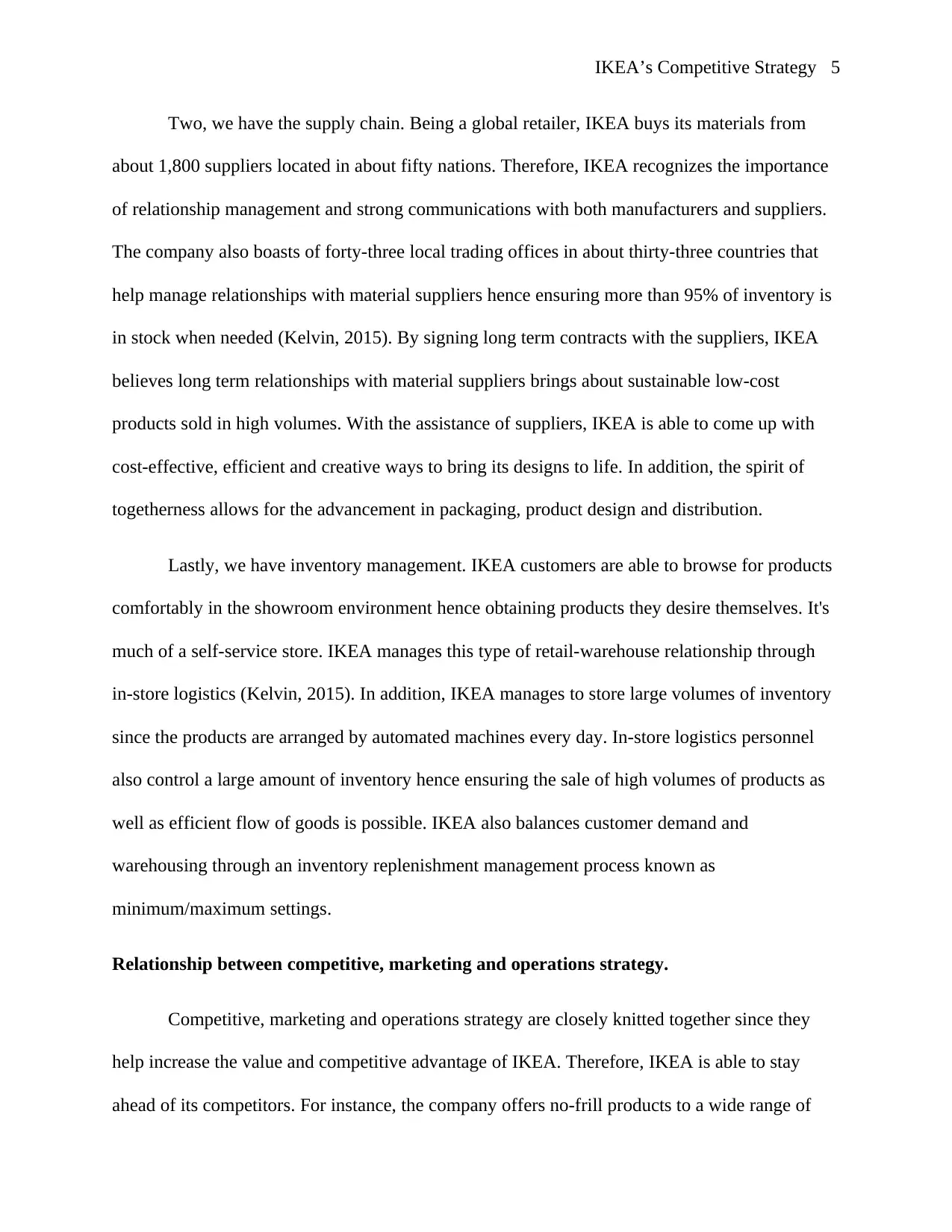
IKEA’s Competitive Strategy 5
Two, we have the supply chain. Being a global retailer, IKEA buys its materials from
about 1,800 suppliers located in about fifty nations. Therefore, IKEA recognizes the importance
of relationship management and strong communications with both manufacturers and suppliers.
The company also boasts of forty-three local trading offices in about thirty-three countries that
help manage relationships with material suppliers hence ensuring more than 95% of inventory is
in stock when needed (Kelvin, 2015). By signing long term contracts with the suppliers, IKEA
believes long term relationships with material suppliers brings about sustainable low-cost
products sold in high volumes. With the assistance of suppliers, IKEA is able to come up with
cost-effective, efficient and creative ways to bring its designs to life. In addition, the spirit of
togetherness allows for the advancement in packaging, product design and distribution.
Lastly, we have inventory management. IKEA customers are able to browse for products
comfortably in the showroom environment hence obtaining products they desire themselves. It's
much of a self-service store. IKEA manages this type of retail-warehouse relationship through
in-store logistics (Kelvin, 2015). In addition, IKEA manages to store large volumes of inventory
since the products are arranged by automated machines every day. In-store logistics personnel
also control a large amount of inventory hence ensuring the sale of high volumes of products as
well as efficient flow of goods is possible. IKEA also balances customer demand and
warehousing through an inventory replenishment management process known as
minimum/maximum settings.
Relationship between competitive, marketing and operations strategy.
Competitive, marketing and operations strategy are closely knitted together since they
help increase the value and competitive advantage of IKEA. Therefore, IKEA is able to stay
ahead of its competitors. For instance, the company offers no-frill products to a wide range of
Two, we have the supply chain. Being a global retailer, IKEA buys its materials from
about 1,800 suppliers located in about fifty nations. Therefore, IKEA recognizes the importance
of relationship management and strong communications with both manufacturers and suppliers.
The company also boasts of forty-three local trading offices in about thirty-three countries that
help manage relationships with material suppliers hence ensuring more than 95% of inventory is
in stock when needed (Kelvin, 2015). By signing long term contracts with the suppliers, IKEA
believes long term relationships with material suppliers brings about sustainable low-cost
products sold in high volumes. With the assistance of suppliers, IKEA is able to come up with
cost-effective, efficient and creative ways to bring its designs to life. In addition, the spirit of
togetherness allows for the advancement in packaging, product design and distribution.
Lastly, we have inventory management. IKEA customers are able to browse for products
comfortably in the showroom environment hence obtaining products they desire themselves. It's
much of a self-service store. IKEA manages this type of retail-warehouse relationship through
in-store logistics (Kelvin, 2015). In addition, IKEA manages to store large volumes of inventory
since the products are arranged by automated machines every day. In-store logistics personnel
also control a large amount of inventory hence ensuring the sale of high volumes of products as
well as efficient flow of goods is possible. IKEA also balances customer demand and
warehousing through an inventory replenishment management process known as
minimum/maximum settings.
Relationship between competitive, marketing and operations strategy.
Competitive, marketing and operations strategy are closely knitted together since they
help increase the value and competitive advantage of IKEA. Therefore, IKEA is able to stay
ahead of its competitors. For instance, the company offers no-frill products to a wide range of
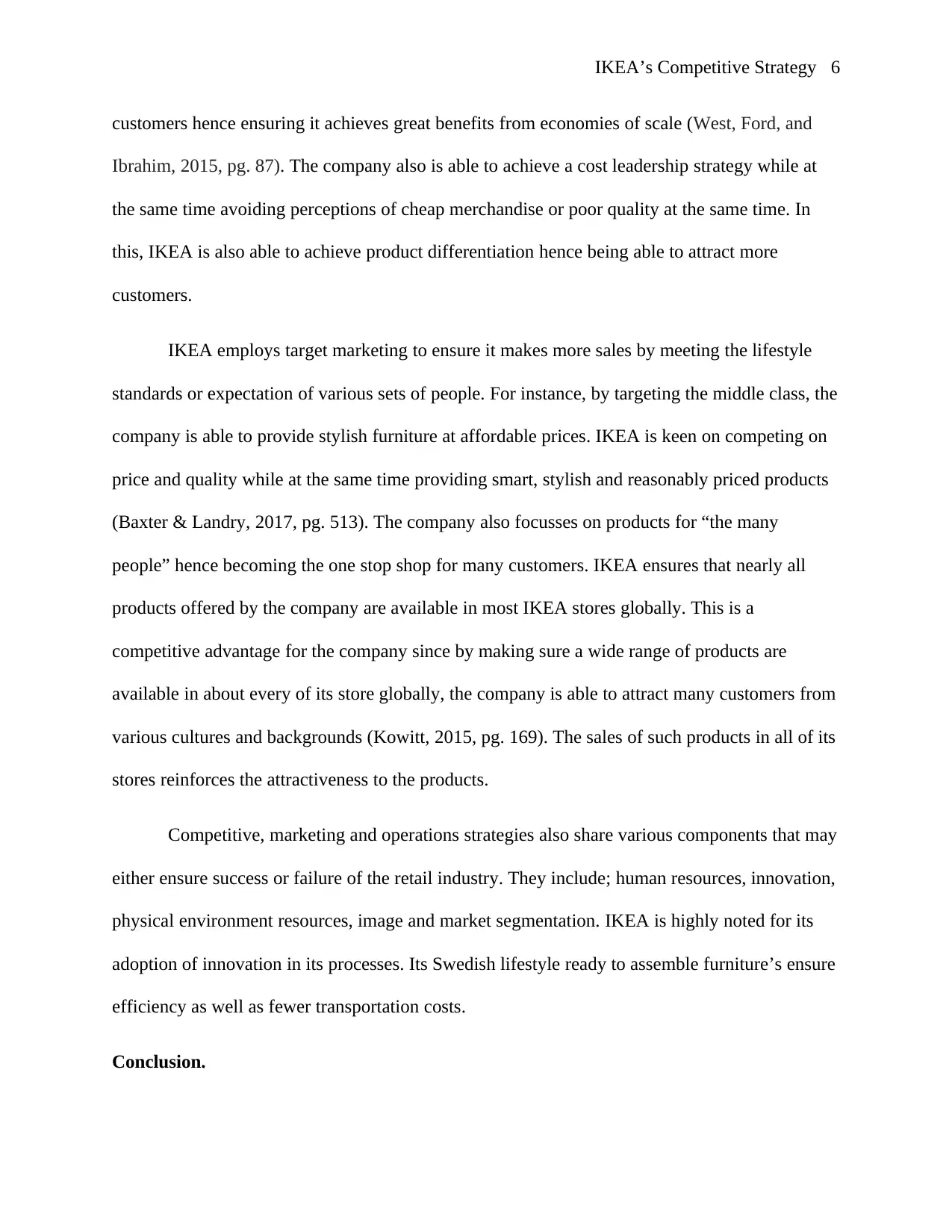
IKEA’s Competitive Strategy 6
customers hence ensuring it achieves great benefits from economies of scale (West, Ford, and
Ibrahim, 2015, pg. 87). The company also is able to achieve a cost leadership strategy while at
the same time avoiding perceptions of cheap merchandise or poor quality at the same time. In
this, IKEA is also able to achieve product differentiation hence being able to attract more
customers.
IKEA employs target marketing to ensure it makes more sales by meeting the lifestyle
standards or expectation of various sets of people. For instance, by targeting the middle class, the
company is able to provide stylish furniture at affordable prices. IKEA is keen on competing on
price and quality while at the same time providing smart, stylish and reasonably priced products
(Baxter & Landry, 2017, pg. 513). The company also focusses on products for “the many
people” hence becoming the one stop shop for many customers. IKEA ensures that nearly all
products offered by the company are available in most IKEA stores globally. This is a
competitive advantage for the company since by making sure a wide range of products are
available in about every of its store globally, the company is able to attract many customers from
various cultures and backgrounds (Kowitt, 2015, pg. 169). The sales of such products in all of its
stores reinforces the attractiveness to the products.
Competitive, marketing and operations strategies also share various components that may
either ensure success or failure of the retail industry. They include; human resources, innovation,
physical environment resources, image and market segmentation. IKEA is highly noted for its
adoption of innovation in its processes. Its Swedish lifestyle ready to assemble furniture’s ensure
efficiency as well as fewer transportation costs.
Conclusion.
customers hence ensuring it achieves great benefits from economies of scale (West, Ford, and
Ibrahim, 2015, pg. 87). The company also is able to achieve a cost leadership strategy while at
the same time avoiding perceptions of cheap merchandise or poor quality at the same time. In
this, IKEA is also able to achieve product differentiation hence being able to attract more
customers.
IKEA employs target marketing to ensure it makes more sales by meeting the lifestyle
standards or expectation of various sets of people. For instance, by targeting the middle class, the
company is able to provide stylish furniture at affordable prices. IKEA is keen on competing on
price and quality while at the same time providing smart, stylish and reasonably priced products
(Baxter & Landry, 2017, pg. 513). The company also focusses on products for “the many
people” hence becoming the one stop shop for many customers. IKEA ensures that nearly all
products offered by the company are available in most IKEA stores globally. This is a
competitive advantage for the company since by making sure a wide range of products are
available in about every of its store globally, the company is able to attract many customers from
various cultures and backgrounds (Kowitt, 2015, pg. 169). The sales of such products in all of its
stores reinforces the attractiveness to the products.
Competitive, marketing and operations strategies also share various components that may
either ensure success or failure of the retail industry. They include; human resources, innovation,
physical environment resources, image and market segmentation. IKEA is highly noted for its
adoption of innovation in its processes. Its Swedish lifestyle ready to assemble furniture’s ensure
efficiency as well as fewer transportation costs.
Conclusion.
⊘ This is a preview!⊘
Do you want full access?
Subscribe today to unlock all pages.

Trusted by 1+ million students worldwide
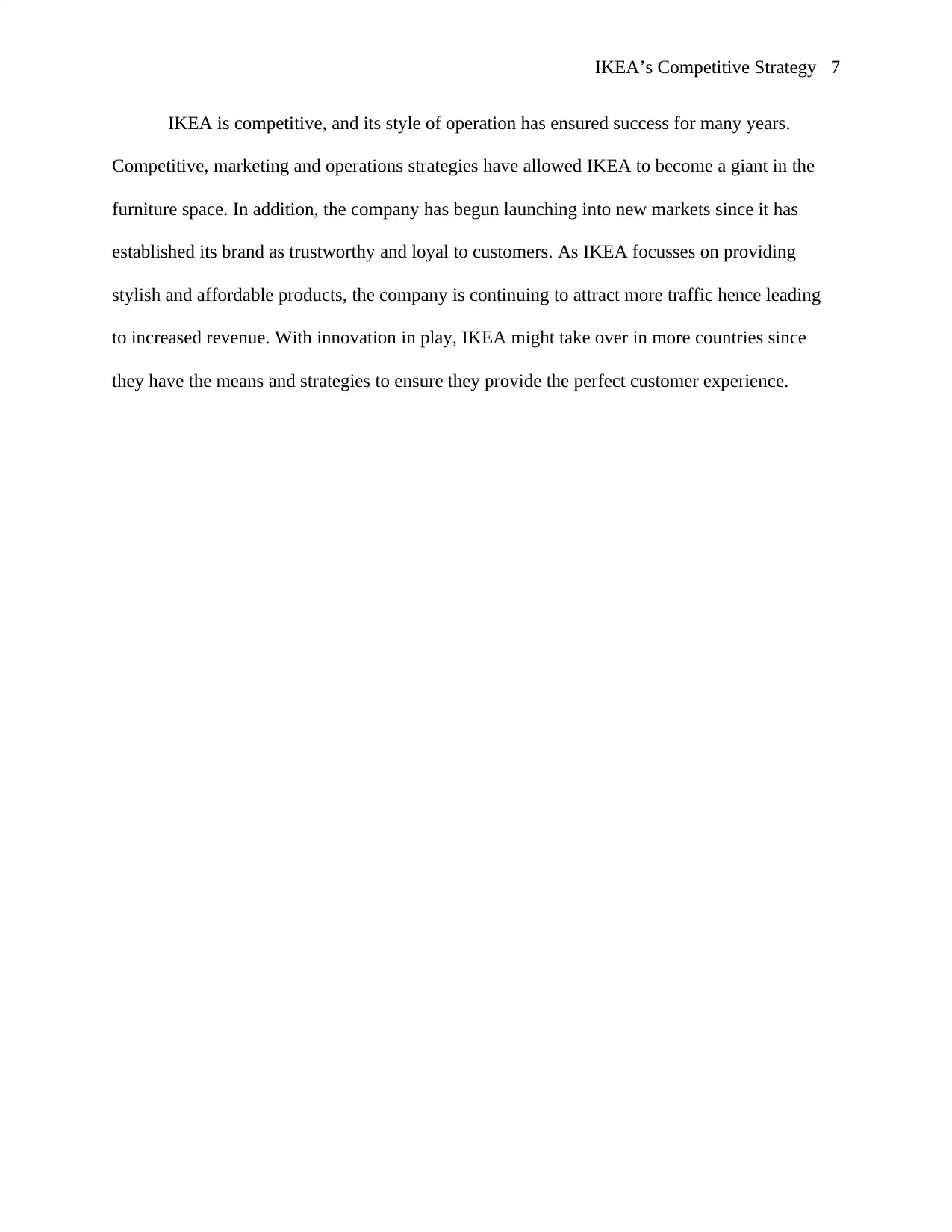
IKEA’s Competitive Strategy 7
IKEA is competitive, and its style of operation has ensured success for many years.
Competitive, marketing and operations strategies have allowed IKEA to become a giant in the
furniture space. In addition, the company has begun launching into new markets since it has
established its brand as trustworthy and loyal to customers. As IKEA focusses on providing
stylish and affordable products, the company is continuing to attract more traffic hence leading
to increased revenue. With innovation in play, IKEA might take over in more countries since
they have the means and strategies to ensure they provide the perfect customer experience.
IKEA is competitive, and its style of operation has ensured success for many years.
Competitive, marketing and operations strategies have allowed IKEA to become a giant in the
furniture space. In addition, the company has begun launching into new markets since it has
established its brand as trustworthy and loyal to customers. As IKEA focusses on providing
stylish and affordable products, the company is continuing to attract more traffic hence leading
to increased revenue. With innovation in play, IKEA might take over in more countries since
they have the means and strategies to ensure they provide the perfect customer experience.
Paraphrase This Document
Need a fresh take? Get an instant paraphrase of this document with our AI Paraphraser
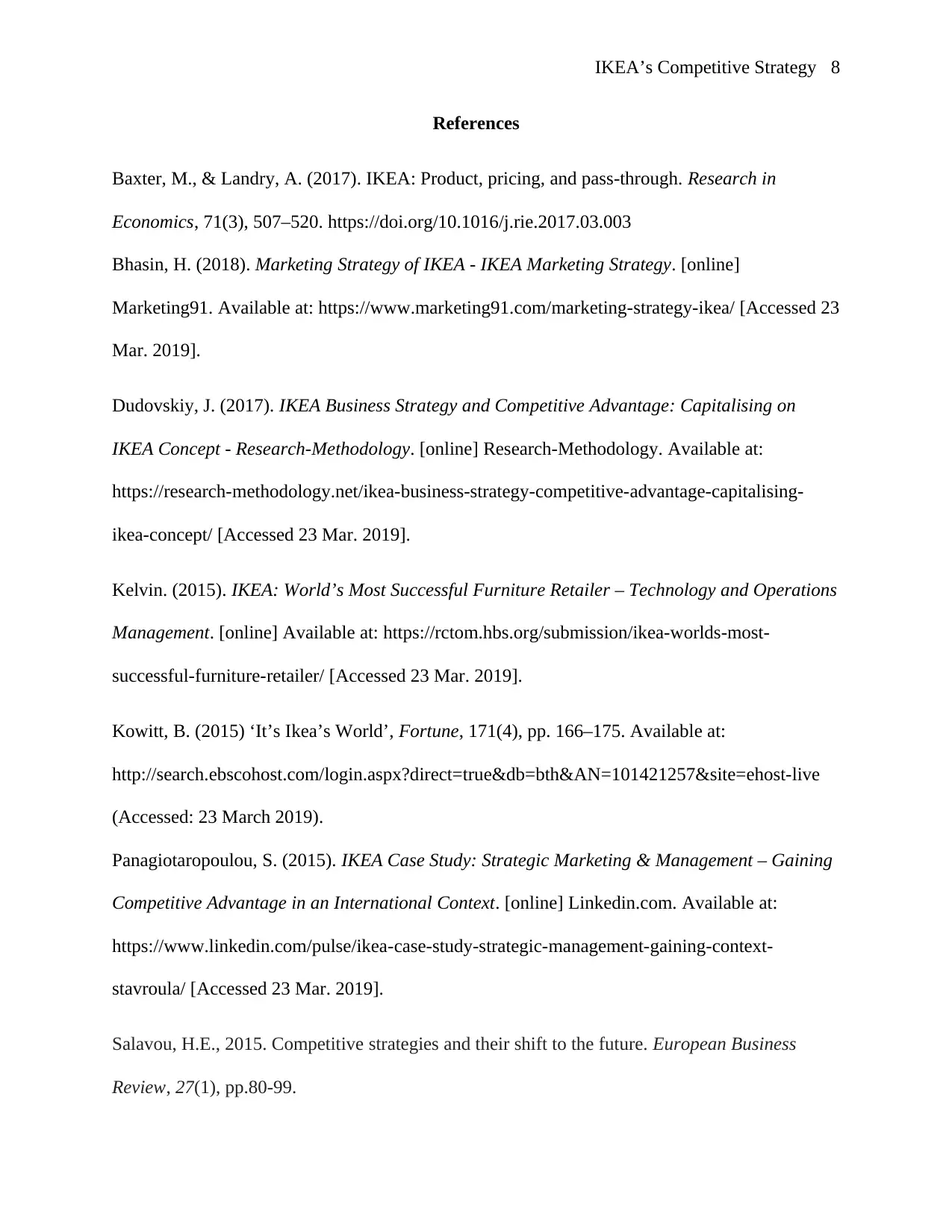
IKEA’s Competitive Strategy 8
References
Baxter, M., & Landry, A. (2017). IKEA: Product, pricing, and pass-through. Research in
Economics, 71(3), 507–520. https://doi.org/10.1016/j.rie.2017.03.003
Bhasin, H. (2018). Marketing Strategy of IKEA - IKEA Marketing Strategy. [online]
Marketing91. Available at: https://www.marketing91.com/marketing-strategy-ikea/ [Accessed 23
Mar. 2019].
Dudovskiy, J. (2017). IKEA Business Strategy and Competitive Advantage: Capitalising on
IKEA Concept - Research-Methodology. [online] Research-Methodology. Available at:
https://research-methodology.net/ikea-business-strategy-competitive-advantage-capitalising-
ikea-concept/ [Accessed 23 Mar. 2019].
Kelvin. (2015). IKEA: World’s Most Successful Furniture Retailer – Technology and Operations
Management. [online] Available at: https://rctom.hbs.org/submission/ikea-worlds-most-
successful-furniture-retailer/ [Accessed 23 Mar. 2019].
Kowitt, B. (2015) ‘It’s Ikea’s World’, Fortune, 171(4), pp. 166–175. Available at:
http://search.ebscohost.com/login.aspx?direct=true&db=bth&AN=101421257&site=ehost-live
(Accessed: 23 March 2019).
Panagiotaropoulou, S. (2015). IKEA Case Study: Strategic Marketing & Management – Gaining
Competitive Advantage in an International Context. [online] Linkedin.com. Available at:
https://www.linkedin.com/pulse/ikea-case-study-strategic-management-gaining-context-
stavroula/ [Accessed 23 Mar. 2019].
Salavou, H.E., 2015. Competitive strategies and their shift to the future. European Business
Review, 27(1), pp.80-99.
References
Baxter, M., & Landry, A. (2017). IKEA: Product, pricing, and pass-through. Research in
Economics, 71(3), 507–520. https://doi.org/10.1016/j.rie.2017.03.003
Bhasin, H. (2018). Marketing Strategy of IKEA - IKEA Marketing Strategy. [online]
Marketing91. Available at: https://www.marketing91.com/marketing-strategy-ikea/ [Accessed 23
Mar. 2019].
Dudovskiy, J. (2017). IKEA Business Strategy and Competitive Advantage: Capitalising on
IKEA Concept - Research-Methodology. [online] Research-Methodology. Available at:
https://research-methodology.net/ikea-business-strategy-competitive-advantage-capitalising-
ikea-concept/ [Accessed 23 Mar. 2019].
Kelvin. (2015). IKEA: World’s Most Successful Furniture Retailer – Technology and Operations
Management. [online] Available at: https://rctom.hbs.org/submission/ikea-worlds-most-
successful-furniture-retailer/ [Accessed 23 Mar. 2019].
Kowitt, B. (2015) ‘It’s Ikea’s World’, Fortune, 171(4), pp. 166–175. Available at:
http://search.ebscohost.com/login.aspx?direct=true&db=bth&AN=101421257&site=ehost-live
(Accessed: 23 March 2019).
Panagiotaropoulou, S. (2015). IKEA Case Study: Strategic Marketing & Management – Gaining
Competitive Advantage in an International Context. [online] Linkedin.com. Available at:
https://www.linkedin.com/pulse/ikea-case-study-strategic-management-gaining-context-
stavroula/ [Accessed 23 Mar. 2019].
Salavou, H.E., 2015. Competitive strategies and their shift to the future. European Business
Review, 27(1), pp.80-99.
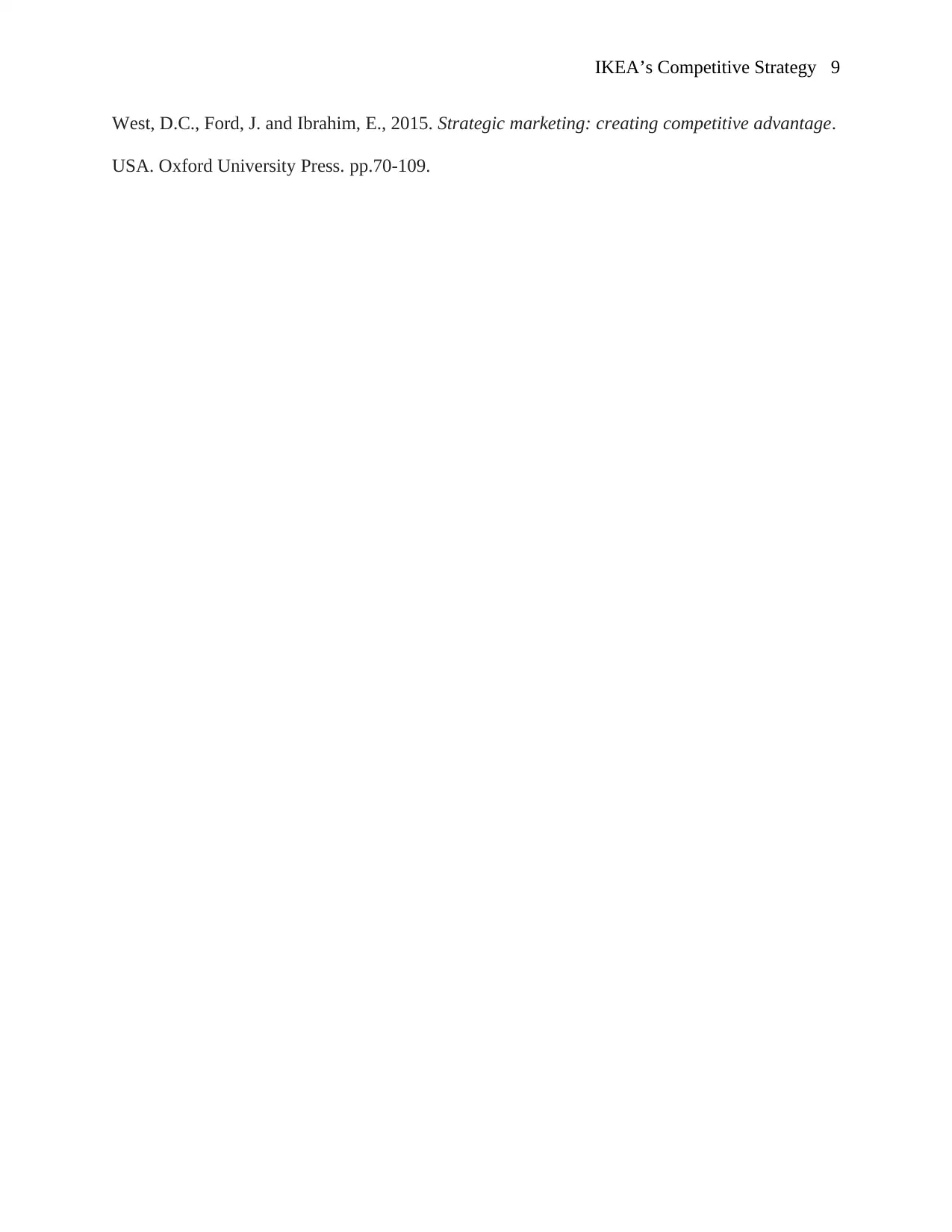
IKEA’s Competitive Strategy 9
West, D.C., Ford, J. and Ibrahim, E., 2015. Strategic marketing: creating competitive advantage.
USA. Oxford University Press. pp.70-109.
West, D.C., Ford, J. and Ibrahim, E., 2015. Strategic marketing: creating competitive advantage.
USA. Oxford University Press. pp.70-109.
⊘ This is a preview!⊘
Do you want full access?
Subscribe today to unlock all pages.

Trusted by 1+ million students worldwide
1 out of 9
Related Documents
Your All-in-One AI-Powered Toolkit for Academic Success.
+13062052269
info@desklib.com
Available 24*7 on WhatsApp / Email
![[object Object]](/_next/static/media/star-bottom.7253800d.svg)
Unlock your academic potential
Copyright © 2020–2025 A2Z Services. All Rights Reserved. Developed and managed by ZUCOL.





